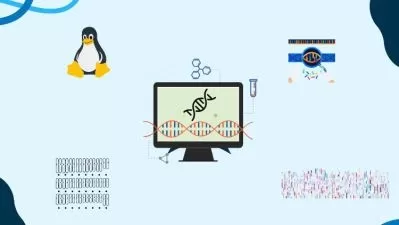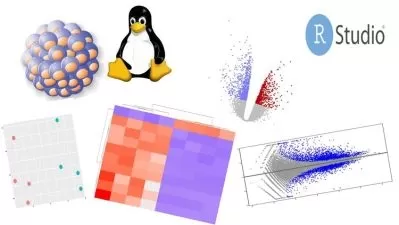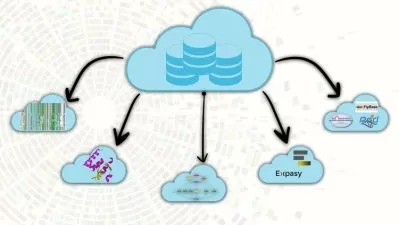Bioinformatics Mastery: Your journey from beginner to Expert
Abdul Rehman Ikram
15:36:32
Description
Bioinformatics Beginners to advance course to learn in 10 hours to understand the simple and complex topics of bioinfo
What You'll Learn?
- Foundational Understanding: Acquire a solid grasp of fundamental bioinformatics concepts, including data analysis, algorithms, and computational techniques.
- Practical Skills Development: Develop hands-on proficiency in utilizing popular bioinformatics tools and software for tasks such as sequence analysis,
- Data Integration Techniques: Learn advanced methods for integrating diverse biological data types, enabling a holistic approach to understanding complex data.
- Problem-Solving Strategies: Enhance problem-solving skills by applying bioinformatics approaches to real-world biological questions and challenges.
- You will learn about the history and applications of bioinformatics
- You will learn Basic demonstration of Bioinformatics tools
- Different databases used in bioinformatics
- Interpretation of Sequence Alignment
- Tools Used in sequence Alignment in bioinformatics
- Alignment Methods and Representation
- They will be able to use and know different categories of sub-databases of NCBI.
- Plant Genome Databases
- Secondary Databases in Bioinformatics
- Protein basic Concepts
- Understanding different techniques for protein prediction
- Understanding Comparative or Homology modeling
- Protein Modeling Using GUI Interface
- Swiss Model hands on training
- Protein Modeling Using CLI Interface
- Protein Modeling Using Modeller
- The basics of Next Generation Sequencing and how it can be used for Differential gene expression analysis via RNA sequencing.
- Quality Control of NGS data
- Trimming the Reads of NGS Data
- Different tools for aligning reads to genome
- Differential Expression Analysis.
- Ultimately understand how technologies like RNA sequencing could be used to identify specific genes that can cause certain conditions.
- Heatmap Generation of Results
- Interpret the results of DEG's
- Understanding Bioinformatics Pipeline concept
- Use of Galaxy for NGS data processing
- Introduction to R
- Data Analysis Using R
- Introduction to Linux
- Data Analysis using Linux
- Introduction to Python
- Data Analysis using Python Language
Who is this for?
What You Need to Know?
More details
DescriptionGet ready to dive into an extensive and in-depth bioinformatics course that is worth every penny and second of your time! This comprehensive program covers a wide range of bioinformatics topics, taking you from a beginner stage to a master level in the field.
The Bioinformatics course offers a holistic overview, encompassing all the essential concepts, tools, and techniques employed in the analysis and interpretation of biological data.
We kick off with a captivating Introduction to Bioinformatics, where you'll explore the rich history and development of the field, understanding its pivotal role in modern biology research. Discover the diverse applications of bioinformatics in genomics, transcriptomics, proteomics, and metabolomics, and witness how it revolutionizes these areas.
In the following section, we delve into Biological Databases. Gain proficiency in navigating and utilizing various database types, including NCBI, Ensembl, and UniProt. Learn the art of effectively searching these databases and master the management of biological data.
Prepare yourself for an enlightening exploration of File Formats in Bioinformatics. Familiarize yourself with commonly used file formats such as FASTA, FASTQ, SAM/BAM, and VCF. Discover valuable tools and techniques for manipulating, converting, and parsing these formats, equipping yourself with essential skills for data manipulation.
Next up, we tackle the intricacies of Sequence Alignment and Tools. Delve into the principles underlying sequence alignment and gain hands-on experience with powerful tools and algorithms like BLAST, ClustalW, and MUSCLE. Learn to interpret and analyze alignment results, extracting meaningful insights from your data.
Command Line Bioinformatics takes center stage in the subsequent section. Unleash the potential of bioinformatics tools and software using the command line interface (CLI). Master fundamental UNIX commands, navigate directories, create and edit files, and seamlessly run bioinformatics tools from the command line.
In Bioinformatics and Genomics on GUI and CLI, we equip you with a versatile skill set. Learn how to leverage graphical user interfaces (GUIs) and CLI-based tools simultaneously. Explore popular GUI-based bioinformatics tools like Geneious and CLC Bio, alongside CLI-based tools such as BWA and GATK. Gain the flexibility to choose the most suitable approach for your bioinformatics endeavors.
As the course draws to a close, we delve into Bioinformatics and Proteomics. Unlock the principles of proteomics and delve into tools and techniques for protein identification, quantification, and analysis. Explore how bioinformatics aids in predicting protein structure and function, as well as designing drugs and therapies based on protein interactions.
Each section of this course offers practical exercises, real-world examples, and valuable insights. You'll work with actual biological data, honing your skills in interpreting and visualizing results, and gaining a profound understanding of the challenges and opportunities bioinformatics presents.
Are you ready to embark on this transformative bioinformatics journey? Enroll in our course today and unlock the limitless potential of this captivating field!
Who this course is for:
- Biologists and Life Scientists: Biologists, molecular biologists, geneticists, and researchers in the life sciences who want to enhance their skills in bioinformatics.
- People generally interested in new research methodologies and would like to try them themselves!
- Beginner Bioinformaticians looking to understand the process of Proteins
- Beginner Bioinformatics Students
- People interested in researching the effects of different pathologies on gene expression or even how gene expression changes over the course of a cell's growth curve.
- People looking to carry out differential gene expression and gene ontology analysis.
- People who want to carry out bioinformatic analysis without the need for complex code.
- Researchers are Encouraged to take this Course.
- Beginners Bioinformatics Students
- Industry Professionals wants to learn Bioinformatics.
Get ready to dive into an extensive and in-depth bioinformatics course that is worth every penny and second of your time! This comprehensive program covers a wide range of bioinformatics topics, taking you from a beginner stage to a master level in the field.
The Bioinformatics course offers a holistic overview, encompassing all the essential concepts, tools, and techniques employed in the analysis and interpretation of biological data.
We kick off with a captivating Introduction to Bioinformatics, where you'll explore the rich history and development of the field, understanding its pivotal role in modern biology research. Discover the diverse applications of bioinformatics in genomics, transcriptomics, proteomics, and metabolomics, and witness how it revolutionizes these areas.
In the following section, we delve into Biological Databases. Gain proficiency in navigating and utilizing various database types, including NCBI, Ensembl, and UniProt. Learn the art of effectively searching these databases and master the management of biological data.
Prepare yourself for an enlightening exploration of File Formats in Bioinformatics. Familiarize yourself with commonly used file formats such as FASTA, FASTQ, SAM/BAM, and VCF. Discover valuable tools and techniques for manipulating, converting, and parsing these formats, equipping yourself with essential skills for data manipulation.
Next up, we tackle the intricacies of Sequence Alignment and Tools. Delve into the principles underlying sequence alignment and gain hands-on experience with powerful tools and algorithms like BLAST, ClustalW, and MUSCLE. Learn to interpret and analyze alignment results, extracting meaningful insights from your data.
Command Line Bioinformatics takes center stage in the subsequent section. Unleash the potential of bioinformatics tools and software using the command line interface (CLI). Master fundamental UNIX commands, navigate directories, create and edit files, and seamlessly run bioinformatics tools from the command line.
In Bioinformatics and Genomics on GUI and CLI, we equip you with a versatile skill set. Learn how to leverage graphical user interfaces (GUIs) and CLI-based tools simultaneously. Explore popular GUI-based bioinformatics tools like Geneious and CLC Bio, alongside CLI-based tools such as BWA and GATK. Gain the flexibility to choose the most suitable approach for your bioinformatics endeavors.
As the course draws to a close, we delve into Bioinformatics and Proteomics. Unlock the principles of proteomics and delve into tools and techniques for protein identification, quantification, and analysis. Explore how bioinformatics aids in predicting protein structure and function, as well as designing drugs and therapies based on protein interactions.
Each section of this course offers practical exercises, real-world examples, and valuable insights. You'll work with actual biological data, honing your skills in interpreting and visualizing results, and gaining a profound understanding of the challenges and opportunities bioinformatics presents.
Are you ready to embark on this transformative bioinformatics journey? Enroll in our course today and unlock the limitless potential of this captivating field!
Who this course is for:
- Biologists and Life Scientists: Biologists, molecular biologists, geneticists, and researchers in the life sciences who want to enhance their skills in bioinformatics.
- People generally interested in new research methodologies and would like to try them themselves!
- Beginner Bioinformaticians looking to understand the process of Proteins
- Beginner Bioinformatics Students
- People interested in researching the effects of different pathologies on gene expression or even how gene expression changes over the course of a cell's growth curve.
- People looking to carry out differential gene expression and gene ontology analysis.
- People who want to carry out bioinformatic analysis without the need for complex code.
- Researchers are Encouraged to take this Course.
- Beginners Bioinformatics Students
- Industry Professionals wants to learn Bioinformatics.
User Reviews
Rating
Abdul Rehman Ikram
Instructor's Courses
Udemy
View courses Udemy- language english
- Training sessions 143
- duration 15:36:32
- Release Date 2024/02/09











